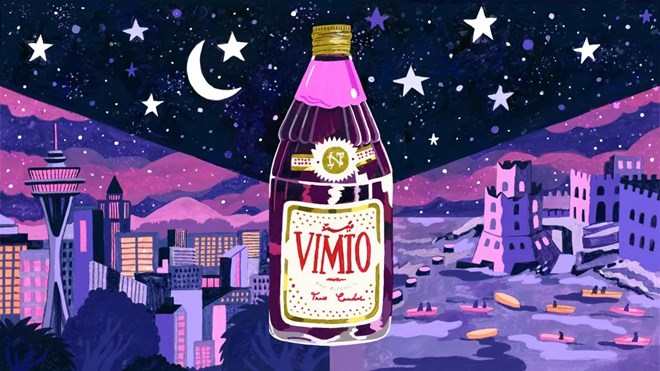
Wednesday December 6, 2023
By Ifrah F. Ahmed
Whether in soda or popsicle form, cut with lime or mixed with milk, Vimto’s particular mix of raspberries, grapes, currants, and spices tastes like celebration
During the Ramadans of my childhood, in the cold and rainy Seattle winters, I remember breaking our fast with sips of water and soft, sticky dates. After our prayers, we’d scramble to help ourselves to the first part of our iftar: crispy fried salmon or beef sambuus (meat-filled fried dumplings) served with spicy green basbaas (hot sauce) and a cool drink of Vimto, a fruit-juice cordial made of raspberries, grapes, black currants, and spices. Following that would be our main meal for the night: bariis iyo hilib ari (rice and goat meat) with a side of banana and basbaas, or baasto iyo suugo with busteeki (pasta and tomato sauce with steak) — also accompanied by a glass of Vimto. I loved Vimto’s sweet and ambiguous fruit flavor. To me, the mixed drink tasted like a bolder and more complex Kool-Aid.
Vimto comes in syrup, soft drink, candy, and even popsicle forms. My mother would pour Vimto syrup from its fancy gold, red, and white bottles and mix a pitcher for us to consume; she’d often cut it with a squeeze of lime and serve it over ice. Whether it was due to the flavor, the boost of much-needed energy, or the joyful feeling of being able to eat and drink after many hours of fasting, drinking Vimto during iftar felt like we were consuming the best thing in the world.
In 1919, Vimto went international, making its way first to British Guiana, then to India in 1924. By 1930, Vimto could be found in over 30 countries, ranging from Peru to Bahrain to Liberia; the drink was first introduced in the Persian Gulf in 1927 and quickly gained a popularity in the Middle East that remains to this day. Vimto made its way to the United States in 1970, where it was beloved by African and Middle Eastern communities that turned to it not just as a little symbol of home, but as the beverage to reach for during Ramadan.
Vimto is a beloved part of iftar, with some stores in the Middle East — where 35 million bottles are sold a year — limiting the number of bottles each customer can buy per month. As a drink initially aimed at those abstaining from alcohol, it’s easy to see how it eventually became an iconic Muslim cultural and culinary tradition. Growing up in the early 2000s, I would often accompany my mother to the local Somali-owned halal stores in south Seattle, where we would purchase spices, fresh goat meat, rice, and — most exciting to me — cans upon cans of Vimto. It was always in my family’s pantry; we had been resettled in the United States as refugees a few years prior and were doing our best to make our new country feel like home. Having access to traditional foods and drinks was one thing that helped us feel comfortable in a new place while keeping us rooted in our culture, so Vimto followed me everywhere I went.
While Vimto is closely associated with Ramadan, its popularity is not limited to that time — it’s always on the table for other holidays like Eid al-Fitr and Eid al-Adha, as well. During parties called martiqaads, where we would have friends, loved ones, and guests from our community over, we’d hand out cans of fizzy Vimto soda for everyone to drink. I loved the vintage look of the label with its neon graphics; it always made me think back to the vibrant photographs of family parties in 1980s Mogadishu that my mom had preserved, where relatives sat around enjoying a meal or were gathered in celebration.
And different regions have their own variations for drinking it. In 2018, I went back to Somalia for the first time since I’d left as a child, and my visit felt like a full circle moment. I tried to absorb as much as I could about Somali cuisine and culture and was particularly delighted by the local love for Vimto mixed with cold milk. The addition of dairy made this a whole new experience, less like sophisticated Kool-Aid and more like a cousin of strawberry milk. For me, that taste will always be a reminder of my time in Somalia.
In 2019, I launched a traveling Somali culinary pop-up called Milk & Myrrh, where I introduced people to Somali culture in cities like New York, Seattle, and Los Angeles. I served coursed-out dinners with a backing track of Somali music and featured classic dishes: sambuus, slow-cooked goat, bariis, anjeero, and sweets. I also served Vimto at my dinners; growing up drinking it during Ramadan, it had always inherently felt like a celebratory treat.
My pop-up dinners were my way of sharing what I most loved about my culture with friends and strangers alike. I tried to replicate the feeling of the martiqaads I grew up with, the satisfaction of consuming Vimto during holidays, and the energy of the photos from my mother’s 1980s-era Somalia. Having Vimto on the table may seem like a small detail, but to me it is the kind of thing that one of my guests might notice and that might make them feel seen. From Pakistan to Palestine to the world over, these small experiences and iconic tastes like Vimto connect so many of our communities and remind me that you can always find a little taste of home, no matter where you are.
Ifrah F. Ahmed is a writer, chef, and founder of the Somali culinary pop-up Milk & Myrrh.
Tilda Rose is a Finnish American artist and illustrator working in editorial and children’s books.
Copy edited by CB Owens
